Exercise Intervention for COPD: Anxiety and Quality of Life Study
VerifiedAdded on 2020/04/21
|7
|1656
|80
Report
AI Summary
This clinical physiology report investigates the effects of a 12-week exercise intervention on anxiety and quality of life in patients with moderate to severe COPD. The study, conducted in the Manawatu region of New Zealand, involved two groups based on COPD severity, with participants undergoing an exercise program at the U-kinetics exercise and wellness clinic. The research hypothesized that the exercise regimen would reduce perceived anxiety, and the results indicated positive changes in HADs scores, with varying impacts on FEV1 results. The moderate COPD group showed significant improvement in anxiety scores, while the severe group showed a delayed effect. The study's findings highlight the benefits of exercise interventions for COPD patients, though the need for additional strategies or longer programs for severe cases is emphasized. Furthermore, the report discusses the impact of comorbidities like anxiety and depression on COPD, and the benefits of aerobic and resistance exercises. The study's limitations include small sample size and the absence of a control group, which impacted the comprehensive evaluation of the intervention. The report suggests future research directions, including strategies to improve self-perception and the impact of longer exercise programs, to enhance outcomes for COPD patients.
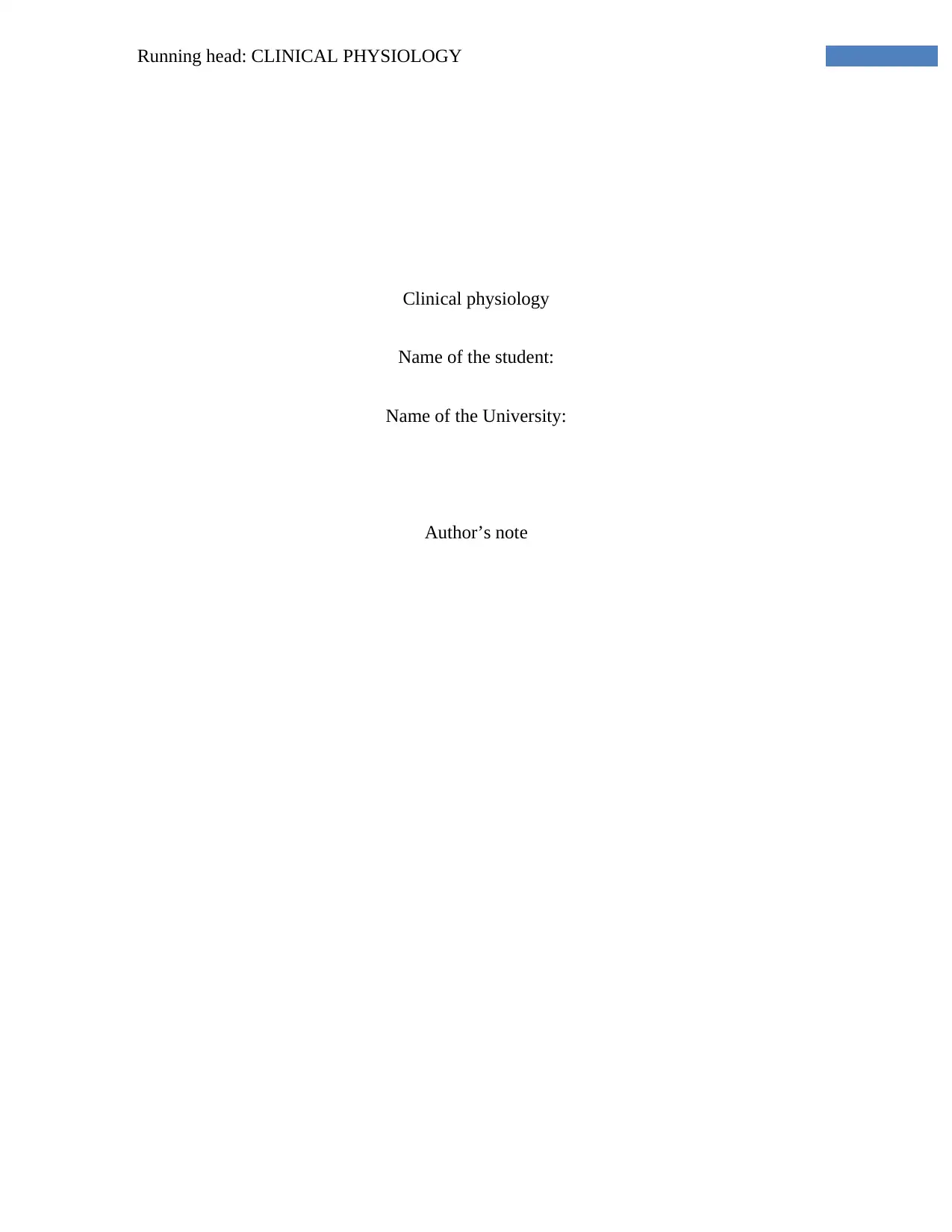
Running head: CLINICAL PHYSIOLOGY
Clinical physiology
Name of the student:
Name of the University:
Author’s note
Clinical physiology
Name of the student:
Name of the University:
Author’s note
Paraphrase This Document
Need a fresh take? Get an instant paraphrase of this document with our AI Paraphraser
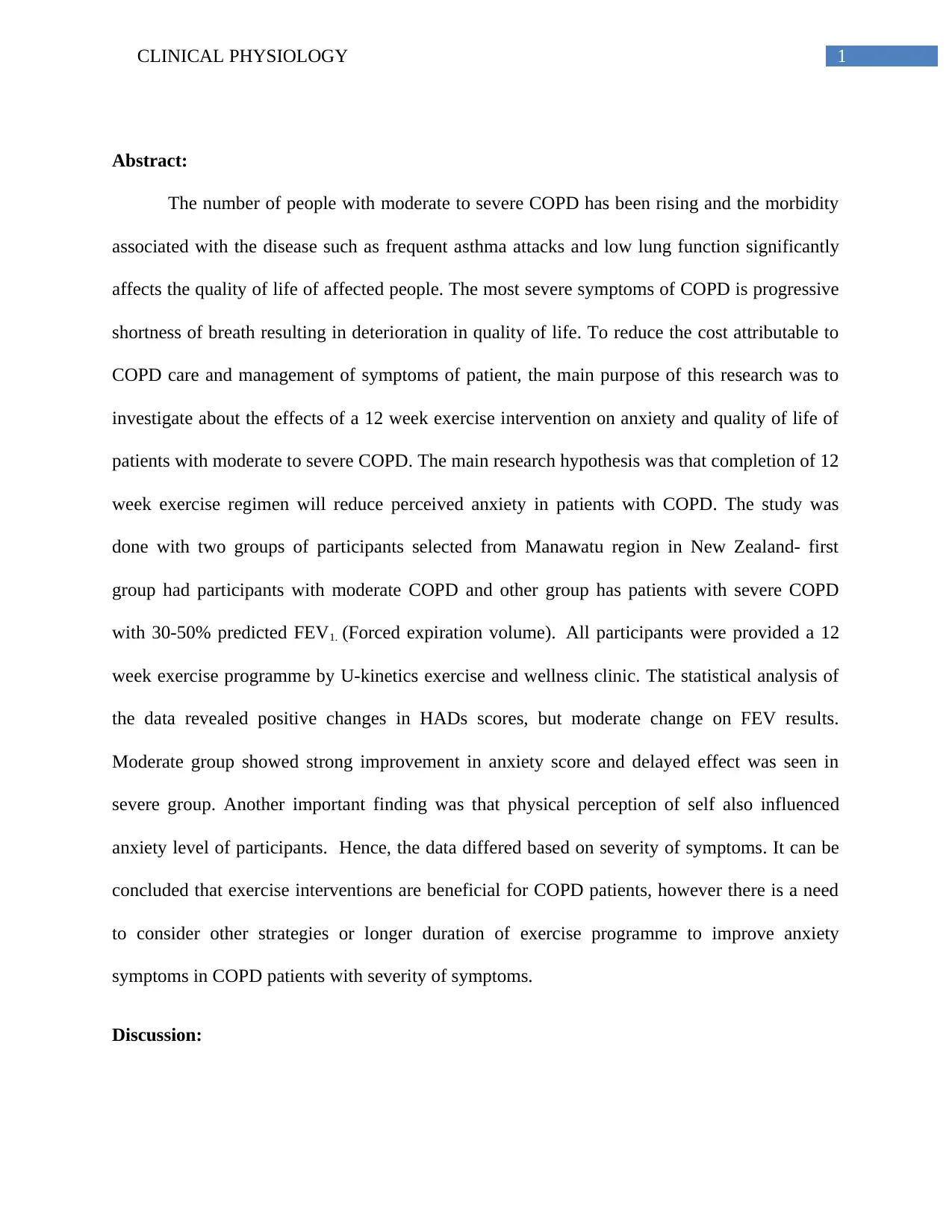
1CLINICAL PHYSIOLOGY
Abstract:
The number of people with moderate to severe COPD has been rising and the morbidity
associated with the disease such as frequent asthma attacks and low lung function significantly
affects the quality of life of affected people. The most severe symptoms of COPD is progressive
shortness of breath resulting in deterioration in quality of life. To reduce the cost attributable to
COPD care and management of symptoms of patient, the main purpose of this research was to
investigate about the effects of a 12 week exercise intervention on anxiety and quality of life of
patients with moderate to severe COPD. The main research hypothesis was that completion of 12
week exercise regimen will reduce perceived anxiety in patients with COPD. The study was
done with two groups of participants selected from Manawatu region in New Zealand- first
group had participants with moderate COPD and other group has patients with severe COPD
with 30-50% predicted FEV1. (Forced expiration volume). All participants were provided a 12
week exercise programme by U-kinetics exercise and wellness clinic. The statistical analysis of
the data revealed positive changes in HADs scores, but moderate change on FEV results.
Moderate group showed strong improvement in anxiety score and delayed effect was seen in
severe group. Another important finding was that physical perception of self also influenced
anxiety level of participants. Hence, the data differed based on severity of symptoms. It can be
concluded that exercise interventions are beneficial for COPD patients, however there is a need
to consider other strategies or longer duration of exercise programme to improve anxiety
symptoms in COPD patients with severity of symptoms.
Discussion:
Abstract:
The number of people with moderate to severe COPD has been rising and the morbidity
associated with the disease such as frequent asthma attacks and low lung function significantly
affects the quality of life of affected people. The most severe symptoms of COPD is progressive
shortness of breath resulting in deterioration in quality of life. To reduce the cost attributable to
COPD care and management of symptoms of patient, the main purpose of this research was to
investigate about the effects of a 12 week exercise intervention on anxiety and quality of life of
patients with moderate to severe COPD. The main research hypothesis was that completion of 12
week exercise regimen will reduce perceived anxiety in patients with COPD. The study was
done with two groups of participants selected from Manawatu region in New Zealand- first
group had participants with moderate COPD and other group has patients with severe COPD
with 30-50% predicted FEV1. (Forced expiration volume). All participants were provided a 12
week exercise programme by U-kinetics exercise and wellness clinic. The statistical analysis of
the data revealed positive changes in HADs scores, but moderate change on FEV results.
Moderate group showed strong improvement in anxiety score and delayed effect was seen in
severe group. Another important finding was that physical perception of self also influenced
anxiety level of participants. Hence, the data differed based on severity of symptoms. It can be
concluded that exercise interventions are beneficial for COPD patients, however there is a need
to consider other strategies or longer duration of exercise programme to improve anxiety
symptoms in COPD patients with severity of symptoms.
Discussion:
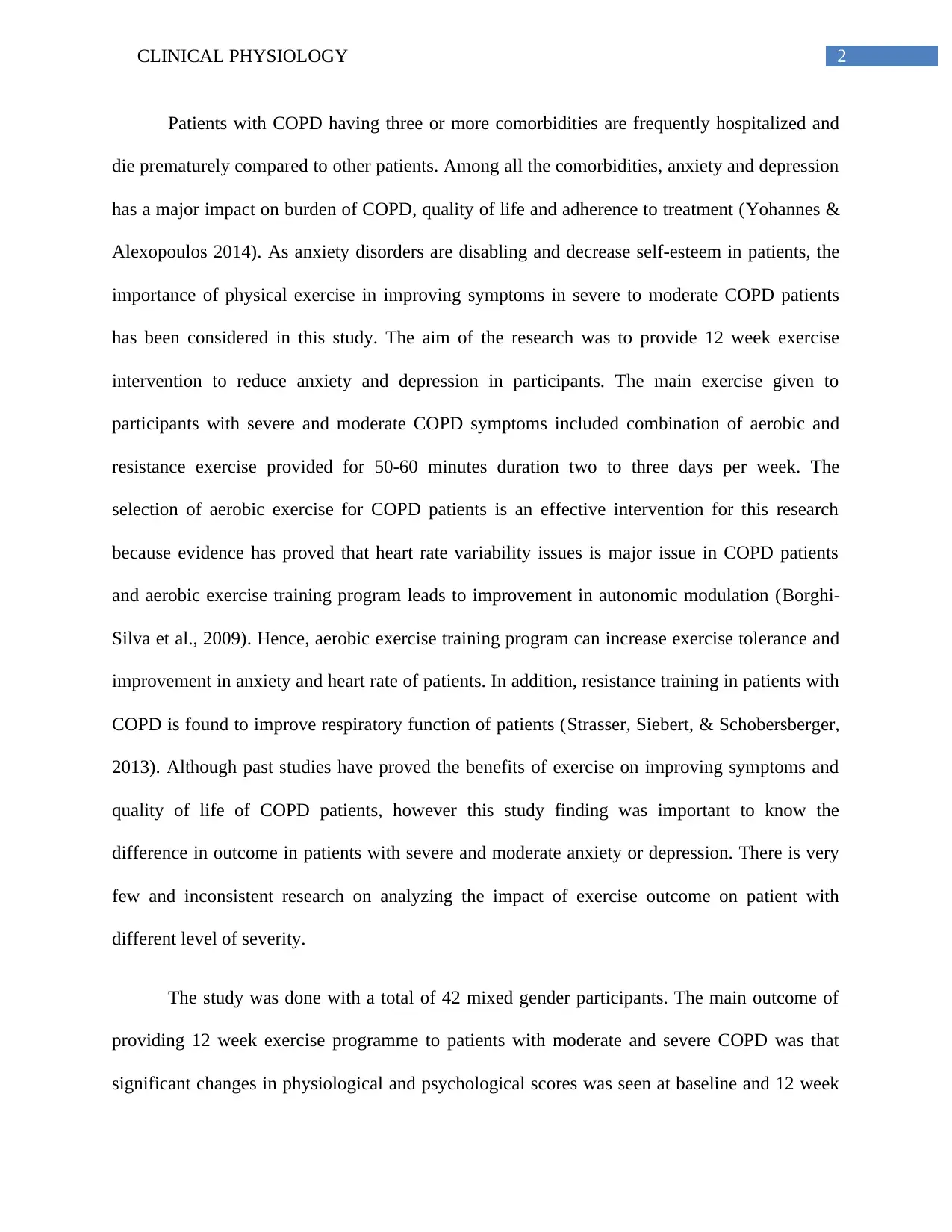
2CLINICAL PHYSIOLOGY
Patients with COPD having three or more comorbidities are frequently hospitalized and
die prematurely compared to other patients. Among all the comorbidities, anxiety and depression
has a major impact on burden of COPD, quality of life and adherence to treatment (Yohannes &
Alexopoulos 2014). As anxiety disorders are disabling and decrease self-esteem in patients, the
importance of physical exercise in improving symptoms in severe to moderate COPD patients
has been considered in this study. The aim of the research was to provide 12 week exercise
intervention to reduce anxiety and depression in participants. The main exercise given to
participants with severe and moderate COPD symptoms included combination of aerobic and
resistance exercise provided for 50-60 minutes duration two to three days per week. The
selection of aerobic exercise for COPD patients is an effective intervention for this research
because evidence has proved that heart rate variability issues is major issue in COPD patients
and aerobic exercise training program leads to improvement in autonomic modulation (Borghi-
Silva et al., 2009). Hence, aerobic exercise training program can increase exercise tolerance and
improvement in anxiety and heart rate of patients. In addition, resistance training in patients with
COPD is found to improve respiratory function of patients (Strasser, Siebert, & Schobersberger,
2013). Although past studies have proved the benefits of exercise on improving symptoms and
quality of life of COPD patients, however this study finding was important to know the
difference in outcome in patients with severe and moderate anxiety or depression. There is very
few and inconsistent research on analyzing the impact of exercise outcome on patient with
different level of severity.
The study was done with a total of 42 mixed gender participants. The main outcome of
providing 12 week exercise programme to patients with moderate and severe COPD was that
significant changes in physiological and psychological scores was seen at baseline and 12 week
Patients with COPD having three or more comorbidities are frequently hospitalized and
die prematurely compared to other patients. Among all the comorbidities, anxiety and depression
has a major impact on burden of COPD, quality of life and adherence to treatment (Yohannes &
Alexopoulos 2014). As anxiety disorders are disabling and decrease self-esteem in patients, the
importance of physical exercise in improving symptoms in severe to moderate COPD patients
has been considered in this study. The aim of the research was to provide 12 week exercise
intervention to reduce anxiety and depression in participants. The main exercise given to
participants with severe and moderate COPD symptoms included combination of aerobic and
resistance exercise provided for 50-60 minutes duration two to three days per week. The
selection of aerobic exercise for COPD patients is an effective intervention for this research
because evidence has proved that heart rate variability issues is major issue in COPD patients
and aerobic exercise training program leads to improvement in autonomic modulation (Borghi-
Silva et al., 2009). Hence, aerobic exercise training program can increase exercise tolerance and
improvement in anxiety and heart rate of patients. In addition, resistance training in patients with
COPD is found to improve respiratory function of patients (Strasser, Siebert, & Schobersberger,
2013). Although past studies have proved the benefits of exercise on improving symptoms and
quality of life of COPD patients, however this study finding was important to know the
difference in outcome in patients with severe and moderate anxiety or depression. There is very
few and inconsistent research on analyzing the impact of exercise outcome on patient with
different level of severity.
The study was done with a total of 42 mixed gender participants. The main outcome of
providing 12 week exercise programme to patients with moderate and severe COPD was that
significant changes in physiological and psychological scores was seen at baseline and 12 week
⊘ This is a preview!⊘
Do you want full access?
Subscribe today to unlock all pages.

Trusted by 1+ million students worldwide
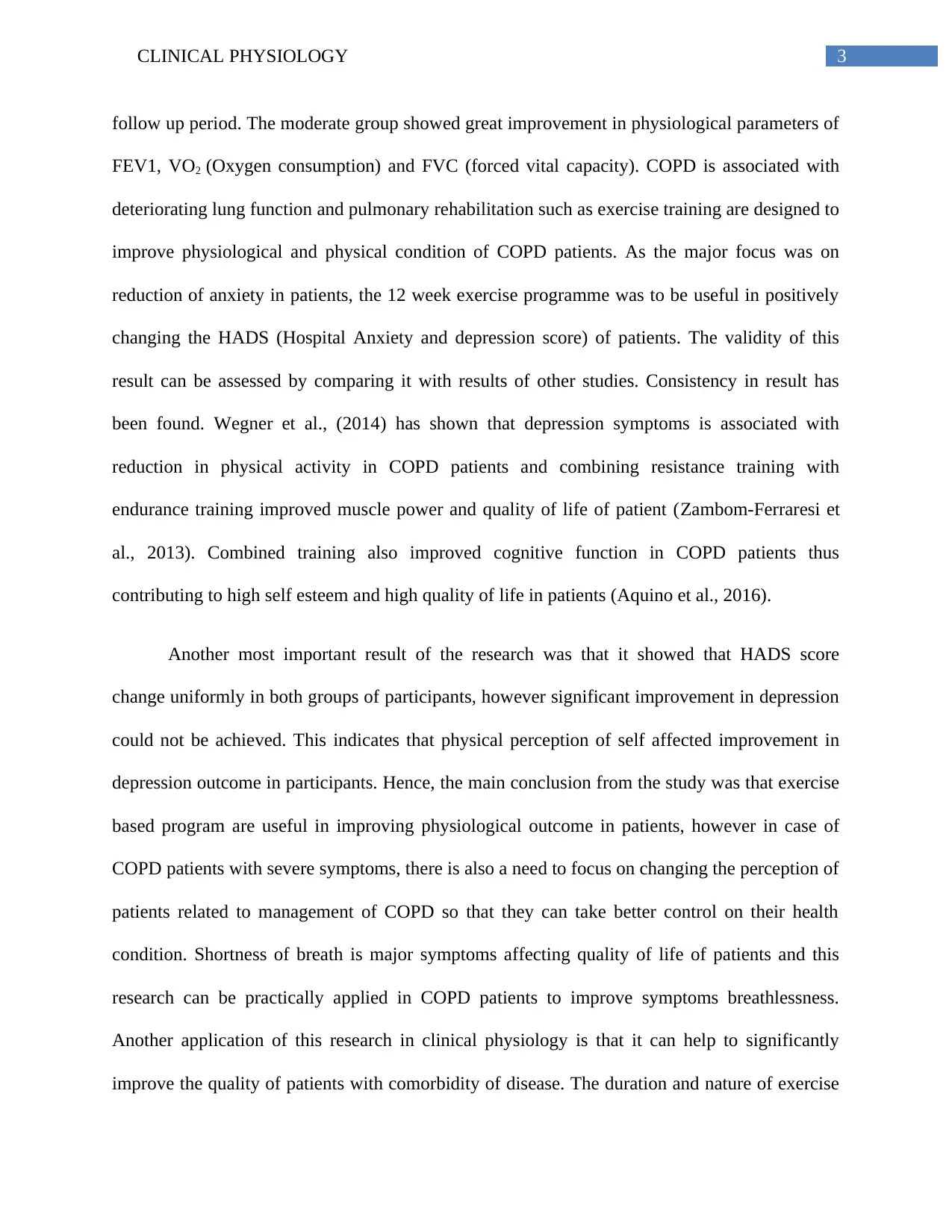
3CLINICAL PHYSIOLOGY
follow up period. The moderate group showed great improvement in physiological parameters of
FEV1, VO2 (Oxygen consumption) and FVC (forced vital capacity). COPD is associated with
deteriorating lung function and pulmonary rehabilitation such as exercise training are designed to
improve physiological and physical condition of COPD patients. As the major focus was on
reduction of anxiety in patients, the 12 week exercise programme was to be useful in positively
changing the HADS (Hospital Anxiety and depression score) of patients. The validity of this
result can be assessed by comparing it with results of other studies. Consistency in result has
been found. Wegner et al., (2014) has shown that depression symptoms is associated with
reduction in physical activity in COPD patients and combining resistance training with
endurance training improved muscle power and quality of life of patient (Zambom-Ferraresi et
al., 2013). Combined training also improved cognitive function in COPD patients thus
contributing to high self esteem and high quality of life in patients (Aquino et al., 2016).
Another most important result of the research was that it showed that HADS score
change uniformly in both groups of participants, however significant improvement in depression
could not be achieved. This indicates that physical perception of self affected improvement in
depression outcome in participants. Hence, the main conclusion from the study was that exercise
based program are useful in improving physiological outcome in patients, however in case of
COPD patients with severe symptoms, there is also a need to focus on changing the perception of
patients related to management of COPD so that they can take better control on their health
condition. Shortness of breath is major symptoms affecting quality of life of patients and this
research can be practically applied in COPD patients to improve symptoms breathlessness.
Another application of this research in clinical physiology is that it can help to significantly
improve the quality of patients with comorbidity of disease. The duration and nature of exercise
follow up period. The moderate group showed great improvement in physiological parameters of
FEV1, VO2 (Oxygen consumption) and FVC (forced vital capacity). COPD is associated with
deteriorating lung function and pulmonary rehabilitation such as exercise training are designed to
improve physiological and physical condition of COPD patients. As the major focus was on
reduction of anxiety in patients, the 12 week exercise programme was to be useful in positively
changing the HADS (Hospital Anxiety and depression score) of patients. The validity of this
result can be assessed by comparing it with results of other studies. Consistency in result has
been found. Wegner et al., (2014) has shown that depression symptoms is associated with
reduction in physical activity in COPD patients and combining resistance training with
endurance training improved muscle power and quality of life of patient (Zambom-Ferraresi et
al., 2013). Combined training also improved cognitive function in COPD patients thus
contributing to high self esteem and high quality of life in patients (Aquino et al., 2016).
Another most important result of the research was that it showed that HADS score
change uniformly in both groups of participants, however significant improvement in depression
could not be achieved. This indicates that physical perception of self affected improvement in
depression outcome in participants. Hence, the main conclusion from the study was that exercise
based program are useful in improving physiological outcome in patients, however in case of
COPD patients with severe symptoms, there is also a need to focus on changing the perception of
patients related to management of COPD so that they can take better control on their health
condition. Shortness of breath is major symptoms affecting quality of life of patients and this
research can be practically applied in COPD patients to improve symptoms breathlessness.
Another application of this research in clinical physiology is that it can help to significantly
improve the quality of patients with comorbidity of disease. The duration and nature of exercise
Paraphrase This Document
Need a fresh take? Get an instant paraphrase of this document with our AI Paraphraser
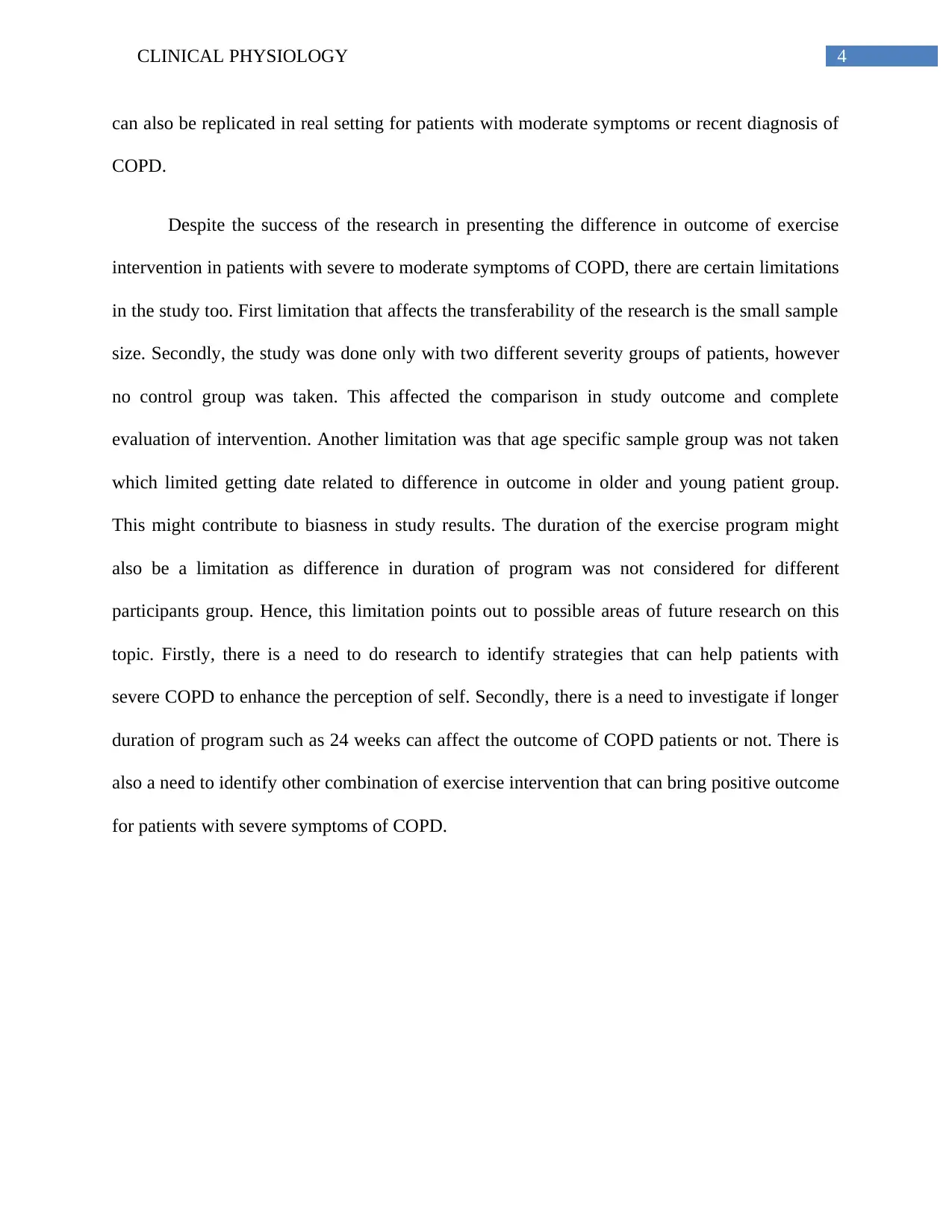
4CLINICAL PHYSIOLOGY
can also be replicated in real setting for patients with moderate symptoms or recent diagnosis of
COPD.
Despite the success of the research in presenting the difference in outcome of exercise
intervention in patients with severe to moderate symptoms of COPD, there are certain limitations
in the study too. First limitation that affects the transferability of the research is the small sample
size. Secondly, the study was done only with two different severity groups of patients, however
no control group was taken. This affected the comparison in study outcome and complete
evaluation of intervention. Another limitation was that age specific sample group was not taken
which limited getting date related to difference in outcome in older and young patient group.
This might contribute to biasness in study results. The duration of the exercise program might
also be a limitation as difference in duration of program was not considered for different
participants group. Hence, this limitation points out to possible areas of future research on this
topic. Firstly, there is a need to do research to identify strategies that can help patients with
severe COPD to enhance the perception of self. Secondly, there is a need to investigate if longer
duration of program such as 24 weeks can affect the outcome of COPD patients or not. There is
also a need to identify other combination of exercise intervention that can bring positive outcome
for patients with severe symptoms of COPD.
can also be replicated in real setting for patients with moderate symptoms or recent diagnosis of
COPD.
Despite the success of the research in presenting the difference in outcome of exercise
intervention in patients with severe to moderate symptoms of COPD, there are certain limitations
in the study too. First limitation that affects the transferability of the research is the small sample
size. Secondly, the study was done only with two different severity groups of patients, however
no control group was taken. This affected the comparison in study outcome and complete
evaluation of intervention. Another limitation was that age specific sample group was not taken
which limited getting date related to difference in outcome in older and young patient group.
This might contribute to biasness in study results. The duration of the exercise program might
also be a limitation as difference in duration of program was not considered for different
participants group. Hence, this limitation points out to possible areas of future research on this
topic. Firstly, there is a need to do research to identify strategies that can help patients with
severe COPD to enhance the perception of self. Secondly, there is a need to investigate if longer
duration of program such as 24 weeks can affect the outcome of COPD patients or not. There is
also a need to identify other combination of exercise intervention that can bring positive outcome
for patients with severe symptoms of COPD.
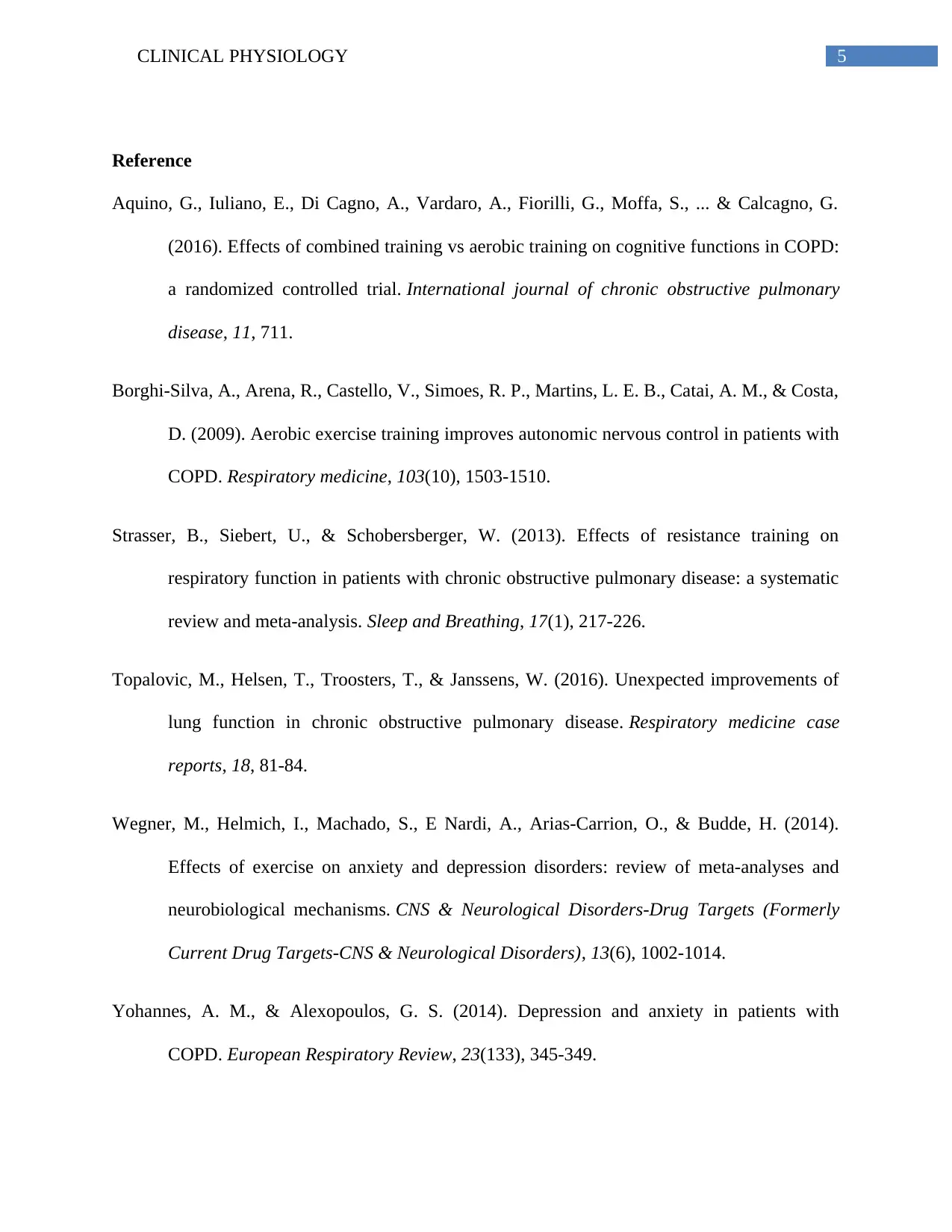
5CLINICAL PHYSIOLOGY
Reference
Aquino, G., Iuliano, E., Di Cagno, A., Vardaro, A., Fiorilli, G., Moffa, S., ... & Calcagno, G.
(2016). Effects of combined training vs aerobic training on cognitive functions in COPD:
a randomized controlled trial. International journal of chronic obstructive pulmonary
disease, 11, 711.
Borghi-Silva, A., Arena, R., Castello, V., Simoes, R. P., Martins, L. E. B., Catai, A. M., & Costa,
D. (2009). Aerobic exercise training improves autonomic nervous control in patients with
COPD. Respiratory medicine, 103(10), 1503-1510.
Strasser, B., Siebert, U., & Schobersberger, W. (2013). Effects of resistance training on
respiratory function in patients with chronic obstructive pulmonary disease: a systematic
review and meta-analysis. Sleep and Breathing, 17(1), 217-226.
Topalovic, M., Helsen, T., Troosters, T., & Janssens, W. (2016). Unexpected improvements of
lung function in chronic obstructive pulmonary disease. Respiratory medicine case
reports, 18, 81-84.
Wegner, M., Helmich, I., Machado, S., E Nardi, A., Arias-Carrion, O., & Budde, H. (2014).
Effects of exercise on anxiety and depression disorders: review of meta-analyses and
neurobiological mechanisms. CNS & Neurological Disorders-Drug Targets (Formerly
Current Drug Targets-CNS & Neurological Disorders), 13(6), 1002-1014.
Yohannes, A. M., & Alexopoulos, G. S. (2014). Depression and anxiety in patients with
COPD. European Respiratory Review, 23(133), 345-349.
Reference
Aquino, G., Iuliano, E., Di Cagno, A., Vardaro, A., Fiorilli, G., Moffa, S., ... & Calcagno, G.
(2016). Effects of combined training vs aerobic training on cognitive functions in COPD:
a randomized controlled trial. International journal of chronic obstructive pulmonary
disease, 11, 711.
Borghi-Silva, A., Arena, R., Castello, V., Simoes, R. P., Martins, L. E. B., Catai, A. M., & Costa,
D. (2009). Aerobic exercise training improves autonomic nervous control in patients with
COPD. Respiratory medicine, 103(10), 1503-1510.
Strasser, B., Siebert, U., & Schobersberger, W. (2013). Effects of resistance training on
respiratory function in patients with chronic obstructive pulmonary disease: a systematic
review and meta-analysis. Sleep and Breathing, 17(1), 217-226.
Topalovic, M., Helsen, T., Troosters, T., & Janssens, W. (2016). Unexpected improvements of
lung function in chronic obstructive pulmonary disease. Respiratory medicine case
reports, 18, 81-84.
Wegner, M., Helmich, I., Machado, S., E Nardi, A., Arias-Carrion, O., & Budde, H. (2014).
Effects of exercise on anxiety and depression disorders: review of meta-analyses and
neurobiological mechanisms. CNS & Neurological Disorders-Drug Targets (Formerly
Current Drug Targets-CNS & Neurological Disorders), 13(6), 1002-1014.
Yohannes, A. M., & Alexopoulos, G. S. (2014). Depression and anxiety in patients with
COPD. European Respiratory Review, 23(133), 345-349.
⊘ This is a preview!⊘
Do you want full access?
Subscribe today to unlock all pages.

Trusted by 1+ million students worldwide
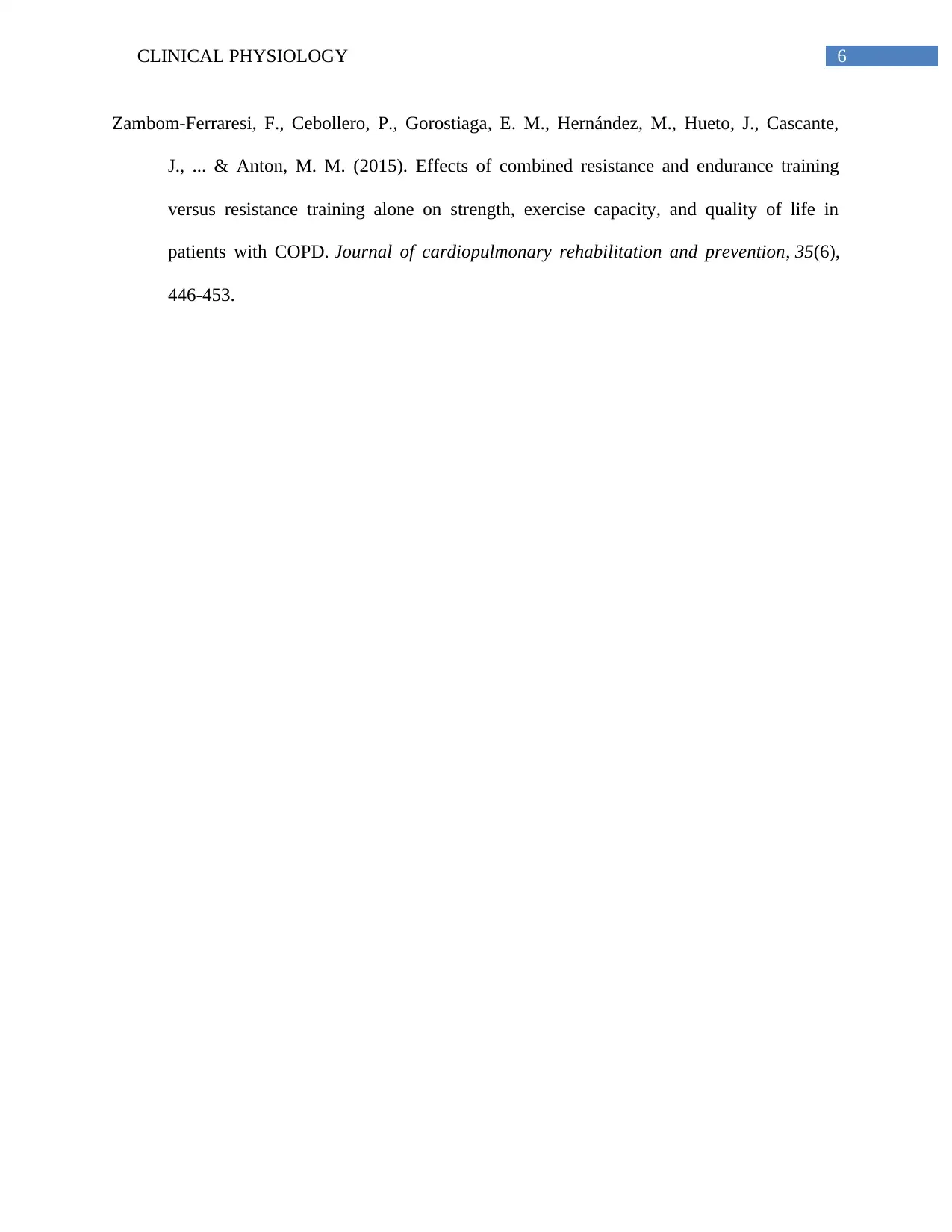
6CLINICAL PHYSIOLOGY
Zambom-Ferraresi, F., Cebollero, P., Gorostiaga, E. M., Hernández, M., Hueto, J., Cascante,
J., ... & Anton, M. M. (2015). Effects of combined resistance and endurance training
versus resistance training alone on strength, exercise capacity, and quality of life in
patients with COPD. Journal of cardiopulmonary rehabilitation and prevention, 35(6),
446-453.
Zambom-Ferraresi, F., Cebollero, P., Gorostiaga, E. M., Hernández, M., Hueto, J., Cascante,
J., ... & Anton, M. M. (2015). Effects of combined resistance and endurance training
versus resistance training alone on strength, exercise capacity, and quality of life in
patients with COPD. Journal of cardiopulmonary rehabilitation and prevention, 35(6),
446-453.
1 out of 7
Related Documents
Your All-in-One AI-Powered Toolkit for Academic Success.
+13062052269
info@desklib.com
Available 24*7 on WhatsApp / Email
![[object Object]](/_next/static/media/star-bottom.7253800d.svg)
Unlock your academic potential
Copyright © 2020–2025 A2Z Services. All Rights Reserved. Developed and managed by ZUCOL.





